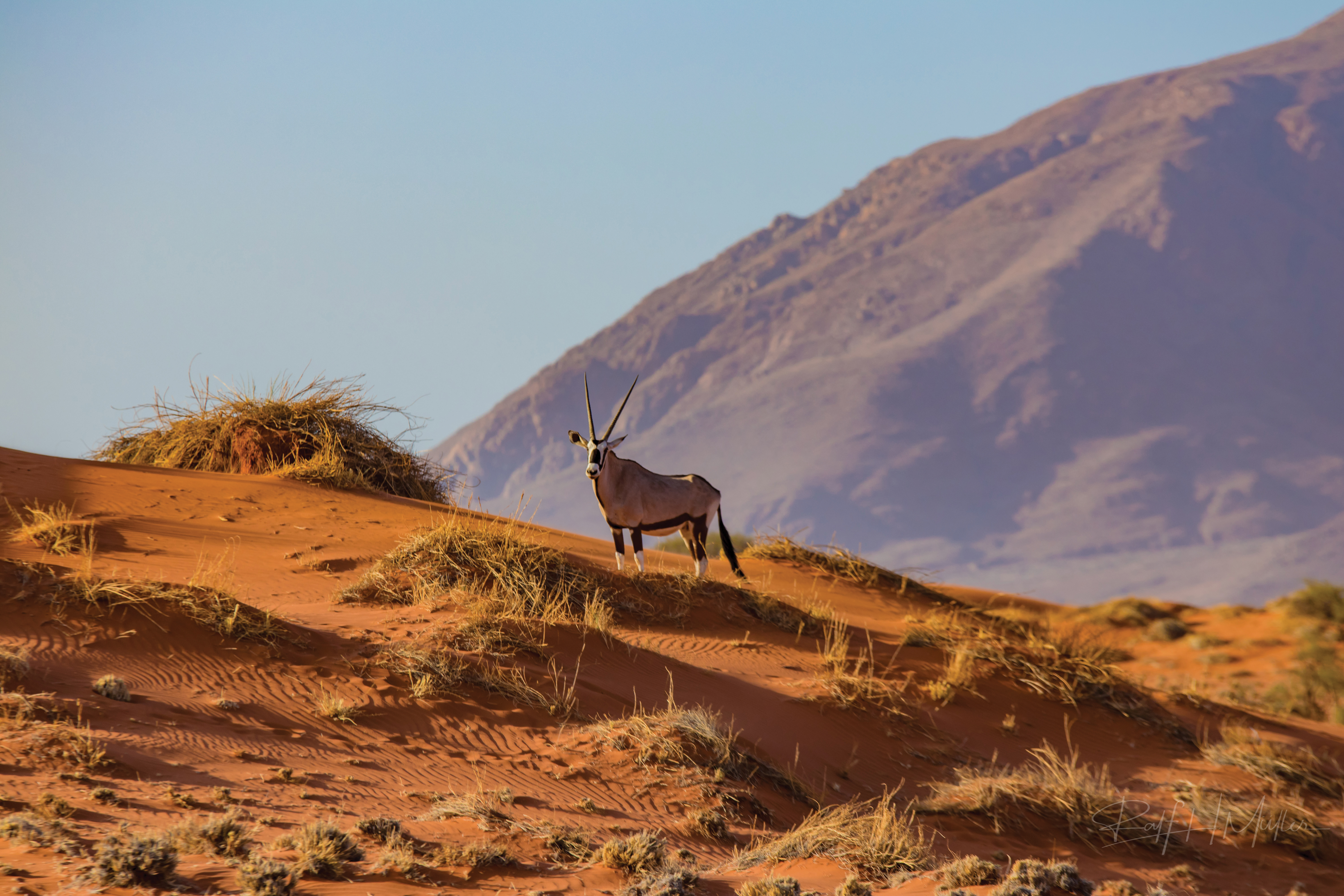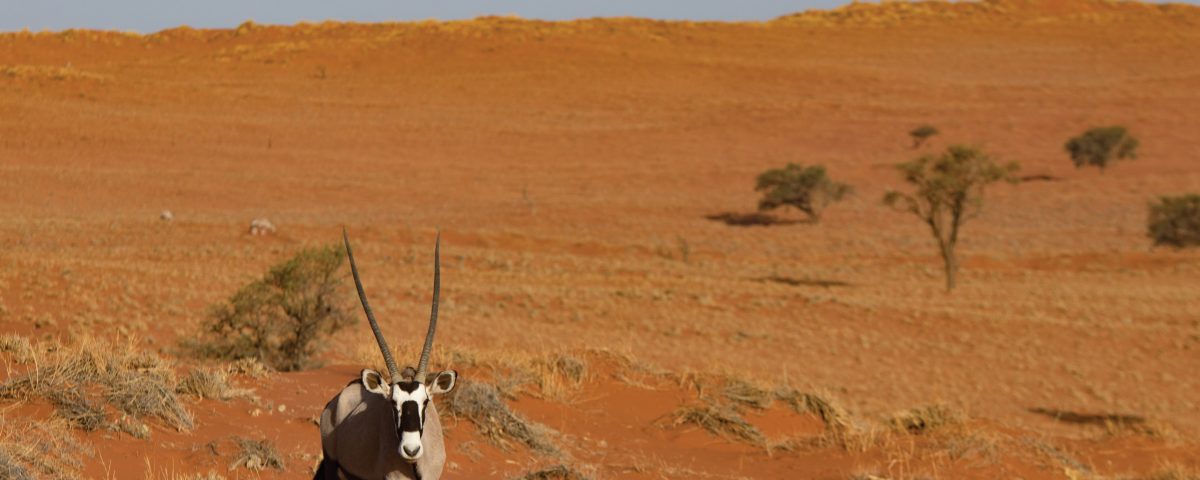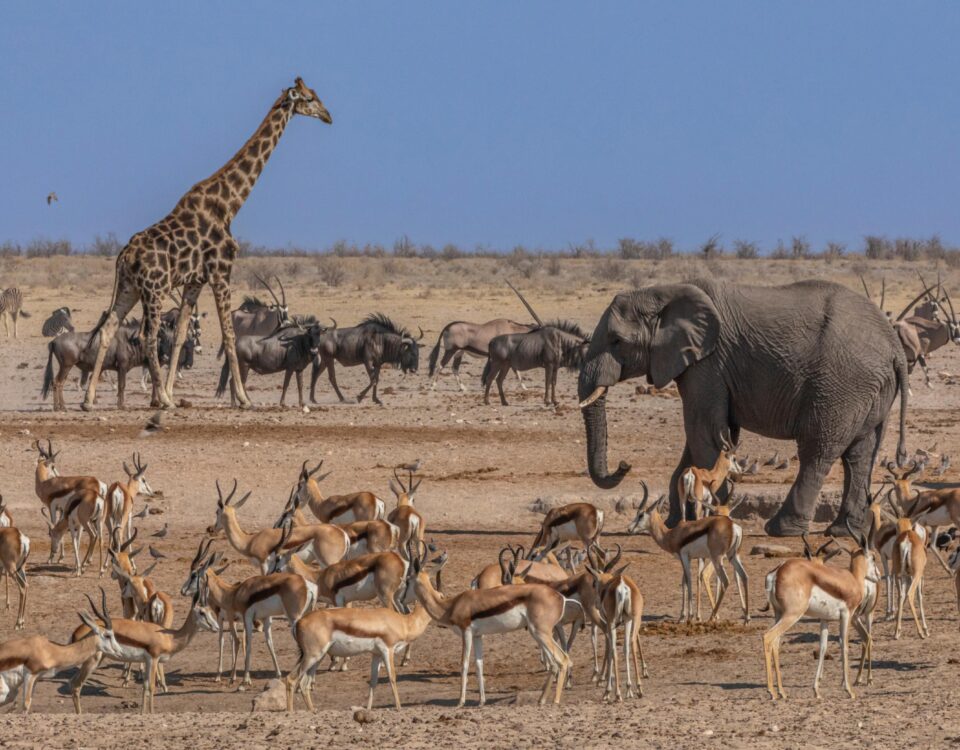
Hunting is part of a Successful Conservation Model
January 10, 2019
How I learnt to love the Desert
January 11, 2019The gemsbok has grazed throughout the night to escape the heat of the desert’s scorched lands. It now stands in the direct sun, with burning sand under its hooves, shifting its weight ever so often. It hasn’t had water on its blackened tongue for weeks. It has maintained its diet by scenting out roots and bulbs, and digging them out of the sand with its strong, sharp, heavy hooves, quenching its forgotten thirst by lucky finds of moisture.
It is a land often overlooked: when Africa is conjured up in the mind, many see lush savannahs and jungles. But the Kalahari and Namib deserts are regions defined by drought, and they test survival on a daily basis, of man and beast alike.
Lance and I have left camp early, grateful for the blessed coolness of morning which his frame, through years of a semi-sedentary life, has been unable to cope with without discomfort and irritation. The gentle, refreshing hand of the dew made for a brisk and hopeful walk along the landscape that consists of vast plains, haunted by mirages – usually mere piles of bare rock – and sand dunes, massed and tangled. But soon the greedy sun claims the last drop of moisture from the air and sands. We push on and pass some bustards and snakes, and golden spots of springbok in the distance.
On reaching a small dune we climb to the top, lie down on our stomachs and carefully scan the plains from east to west. A faint breeze swirls gracefully over our perspiring bodies. While we lie prone, a jackal shambles up the steep slope of loose sand and meets us, face to face. The creature regards us with bewilderment for a second and then dashes back with a yelp of dismay. Lance gazes my way quickly and searches my face for a reaction but I just smile while scanning through my binoculars, and we share this moment without exchanging a word.
The day has now returned in full force and flung us to the lions of the sun. Temperatures must be around the 40s. But the desert doesn’t care. She is too strong to have sympathy, too majestic to be moved by grief or touched by any regret. The sun is beating down fiercely and the sand over which we trudge burns through the soles of our shoes. If desert plants can feel and think, how they must long for the night – for the miracle of cool moisture. “Let’s push on and forget about the heat”, I try to motivate my friend.
On the right, rising from the empty scenery, a small thicket of black sticks becomes visible. Irregular groups of them, standing at various angles, they appear clear and distinct through the transparent air. The rest of the gemsbok is out of sight, nothing is visible but their long and straight horns. But soon the trembling of the earth betrays us, and the thicket of “black sticks” becomes agitated. It breaks up, scatters and regroups in smaller thickets. Then the herd of gemsbok swings away at a gallop and speeds upwind, leaving a long trail of dust to mark its course and finally melting into the mirage.
Far off, ahead of the heard, the aristocrat of the desert, the lone bull, is resting in the midday gloom under the scant shade of a tree, surrounded by miniature pyramids of dry gemsbok droppings, the moisture fully depleted by his own body before marking this area as his territory. He has left the herd months ago, not at all bothered by leaving the females to their fate. They have their own lethal set of horns to defend themselves and their young. He is old and tired, and the natural instinct to pass on his genes for future herds is long lost. He faces the slight breeze, pants, inhales and exhales rapidly through his nose; a nose lined with capillaries, a network of small blood vessels that are cooled by the air pulled into the nose to ensure that blood enters his brain at a lower temperature.
Lance and I don’t escape our share of hardship: the sun is scorching and the sand is extremely hot under our feet. Water is unobtainable as a rule, except for the supply we carry with us and that previously cool refreshment has now turned to high tea temperature. Even so, we wash it down eagerly, soothing our dried throats. The heat reflecting off the ground and stones is a burden and almost a misery, yet we are able to endure it while in motion. But the stillness of the desert and the glare from the surroundings are weighing Lance down. “Shade – coolness – where are they to be found”, he asks as he looks at me dejectedly. “Even darkness will be a relief.” I realise that something approaching despair seizes him, and I feel close to calling it a day and turning back.

But then, as if the mirage were playing a trick on my eyes, I spot a tree in the distance towards the west. As Lance turns towards the slight breeze that plays through my hair, he regains some enthusiasm and puts my thought into words: “Wind in your face, sun at your back.” With renewed hope, we turn westward and head for the luxurious tree. Suddenly, and with our sights set on the shady tree in the distance, three gemsbok calves rise at a distance of about sixty metres and look at us fixedly. About three to four months old, they are a most extraordinary sight. Their necks, chests and flanks are covered with long hair in a vivid hue of red. They have shaggy red manes and big, black, muzzles; their ears are enormous. Lance mistakes them for lion and becomes worked up with terror until I am able to persuade him of the true nature of the animals. Eventually, after the adrenaline rush through his body subsides, we are able to continue. The gemsbok calves gallop off in confusion, sweeping left and right, and finally speeding towards the direction where we last saw the big herd disappear and drop off the end of the earth. I admire their agile movements in the rocky terrain, which poses no obstacle for gemsbok, and contemplate the divisions of their hooves, connected by a strong membrane of muscle, expanding widely and stretching apart when they tread on a stone, the membrane serving as a supporting spring.
And then, as we direct our gaze back to the longed-for tree with its inviting cool, I spot the slight movement of a white underbelly from below the tree and whisper excitedly to Lance to look at it through his binoculars. In his attempt to lessen the burden of the ever-increasing weight of his rifle and binoculars slung over his left shoulder, he has moments before moved the binoculars to the other shoulder. Now the slings are so entangled that he cannot lift the binoculars high enough to align it with his eyes, so eager for a good view of a possible magnificent bull. Finally, with sweaty fingers slipping and sliding over the warm binoculars, Lance lays eyes on the striking beast. Together we goggle at the black and white pattern around its legs and underbelly, the famous facial markings, all of these serving to defect the heat, but making the gemsbok so admirably beautiful – the crowning result of a long period of evolution – developed by unrestricted Nature for the all-wise end of making him attractive in the eyes of the females of his species. He is a mere 200 metres away, still facing away from us.
Lance and I swiftly move closer, his back arched low, my head bent downwards, hoping that the gemsbok will not awake from his slumber or sense us closing in on him. But when at 120 metres away from the gemsbok I raise my head to take a quick look, it is as if he had read my mind–the famous 6th sense of gemsbok has already kicked in. He is facing us now, his black and white face an expression of solitude and strength. He stands still as a statue, defying his enemy. His wire-like hair erect and quivering; his red nostrils, shaped like a trumpet, seem to exude defiance; his shoulders and flanks heavily striated with muscle fibre. My eyes are drawn to his deadly weapon, the long, slim, pitch-black horns shimmering in the sun, and a quick thought plays with my sub-conscience… that the gemsbok, without breaking his stride, can sweep his formidable horns as quick as lightning and impale anything within a metre on either side of his hooves.
He is a noble brute – a leader among the gemsbok. And at this moment I am not eager for Lance to shoot. Suddenly I am content to gaze at the enthralling, impassive face; to admire that quality in it which a hunter lacks most – the steadfastness and endurance. I, the hunter, who so much longed to take this formidable swordsman with my friend, now want to revere and love him – not for his fleeting beauty but because my resilient soul finds him loveable and strong. The hunter’s instinct is the one which is most deeply rooted in the mind of man. It is among those patterns of behaviour which persist after the conditions which triggered them have disappeared.
As Lance slowly lifts his rifle to his shoulder – a second too late, a deliberate moment too long spent scrutinising the beast before us – the gemsbok turns and trots off, as if challenging us to follow. Lance follows him only through his scope, dropping the rifle while the gemsbok pauses on top of a dune, catching the evening breeze, and gazes down on us one last time. I realise that Lance had the same fleeting emotion pass through him.
The desert is in one of its moods of tenderness now – the air full of soft and subtle scents that are sweeter than lavender, more gratifying than wafts from a garden of greenery. A feeling of sadness pulls at our heartstrings. We aren’t immediately sure why, but both Lance and I cannot avoid glum anticipation of what would be coming again too soon – that fierce passion which would cause the sand to turn red-hot under our soles again tomorrow. This anticipation almost destroys our physical pleasure. It is this kind of thing that places man at a disadvantage. Animals, by comparison, live in the immediate present. No matter how beautiful the desert flowers or how rich the fruits of the present may be, a threatening hand stretches out from the future and touches them with destruction. And the farther the eyes of man penetrate the future, the more frightful will be the things revealed.
This both the gemsbok and us hunters know: the great art of the noble sport of gemsbok hunting lies in careful endurance, skill and sense, so as to prevent the animal from taking the only course on which his powers will come to full play.
Day faded from the sky and the dome of stars seemed to be drawn around us like a curtain.
How intensely still it was, how utterly peaceful. The world of men, with its fierce and futile struggles, its crowded and ever-changing image, seemed but a dream. Could it be that in other regions of the world, a world which right here seemed so straightforward, so sinless and so ordered, people were struggling in industrial cities? For this night, however, the desert was the only reality. Where Lance and I seemed to have reached Nirvana…
Footnote: The gemsbok has several interesting peculiarities. Namibians think so highly of the gemsbok, Oryx gazella, that the national coat of arms depicts two of these magnificent animals on either side of a shield covered with the national flag – representing courage, elegance and pride. If you see these antelope in their desert surroundings you will immediately understand their prominent place in the hearts of Namibians.
This article was first published in HuntiNamibia 2019.


